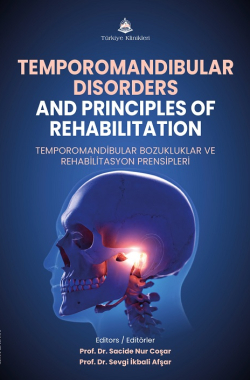PRINCIPLES OF REHABILITATION AFTER SURGERY IN TEMPOROMANDIBULAR DISORDERS
Gönül Ertunç Gülçelik1
Rabia Terzi2
1Kocaeli Health and Technology University, Faculty of Health Sciences, Department of Physiotherapy and Rehabilitation, Kocaeli, Türkiye
2Private Physician, Private Practice of Physical Medicine and Rehabilitation, Kocaeli, Türkiye
Ertunç Gülçelik G, Terzi R. Principles of Rehabilitation After Surgery in Temporomandibular Disorders. In: Coşar SN, Afşar Sİ editors. Temporomandibular Disorders and Principles of Rehabilitation. 1st ed. Ankara: Türkiye Klinikleri; 2025. p.153-158.
ABSTRACT
Temporomandibular disorders (TMD) are a group of neuromuscular disorders that involve the temporomandibular joint (TMJ) complex. In TMD, when conservative treatments are ineffective, there is constant pain and limited functionality, surgical treatments are indicated. The goals of postsurgical rehabilitation are to control pain, reduce inflammation and edema, prevent joint contracture and adhesion formation, and improve the amount of mouth opening. The rehabilitation protocol is a three-phase process that starts within the first 24 hours post surgery and continues for up to eight weeks. The rehabilitation program includes hot and cold applications, Transcutaneous Electrical Nerve Stimulation (TENS) for pain control, normal range of motion exercises in the form of progressive passive, active assistive, active and resistive, specific functional exercises and patient education to prevent complications.As a result, directing patients to regular rehabilitation immediately after surgery and implementing a personalized rehabilitation program increases functional recovery and supports surgical success.
Keywords: Temporomandibular joint disorders; Postoperative care; Rehabilitation; Physical and rehabilitation medicine; Physical therapy modalities
Kaynak Göster
Referanslar
- Gauer RL, Semidey MJ. Diagnosis and treatment of temporomandibular disorders. Am Fam Physician. 2015;91(6):378-386.
- Scrivani SJ, Keith DA, Kaban LB. Temporomandibular disorders. N Engl J Med. 2008;359(25):2693-2705. [Crossref]
- Goncalves DA, Camparis CM, Speciali JG, Franco AL, Castanharo SM, et al Temporomandibular disorders are differentially associated with headache diagnoses: a controlled study. Clin J Pain. 2011;27(7):611-615. [Crossref]
- Lim PF, Smith S, Bhalang K, Slade GD, Maixner W. Development of temporomandibular disorders is associated with greater bodily pain experience. Clin J Pain. 2010;26(2):116-120. [Crossref] [PubMed] [PMC]
- Kindler S, Samietz S, Houshmand M, Grabe HJ, Bernhardt O, Biffar R, et al. Depressive and anxiety symptoms as risk factors for temporomandibular joint pain: a prospective cohort study in the general population. J Pain. 2012;13(12):11881197. [Crossref] [PubMed]
- De Meurechy NK, Loos PJ, Mommaerts MY. Postoperative physiotherapy after open temporomandibular joint surgery: a 3-step program. J Oral Maxillofac Surg. 2019;77(5):932950. [Crossref] [PubMed]
- Schiffman E, Ohrbach R. Executive summary of the Diagnostic Criteria for Temporomandibular Disorders for clinical and research applications. J Am Dent Assoc. 2016;147(6):438-445. [Crossref] [PubMed] [PMC]
- Mujakperuo HR, Watson M, Morrison R, Macfarlane TV. Pharmacological interventions for pain in patients with temporomandibular disorders. Cochrane Database of Systematic Reviews. 2010;6(10). [Crossref] [PubMed]
- Hersh EV, Balasubramaniam R, Pinto A. Pharmacologic management of temporomandibular disorders. Oral Maxillofac Surg Clin North Am. 2008;20(2):197-210. [Crossref] [PubMed]
- Ta LE, Dionne RA. Treatment of painful temporomandibular joints with a cyclooxygenase-2 inhibitor: a randomized placebo-controlled comparison of celecoxib to naproxen. Pain. 2004;111(1-2):13-21. [Crossref] [PubMed]
- List T, Axelsson S, Leijon G. Pharmacologic interventions in the treatment of temporomandibular disorders, atypical facial pain, and burning mouth syndrome. A qualitative systematic review. Journal of orofacial pain. 2003;17(4). [Crossref] [PubMed]
- Kandasamy S, Greene CS. The evolution of temporomandibular disorders: A shift from experience to evidence. J Oral Pathol Med. 2020;49(6):461-469. [Crossref] [PubMed]
- Aggarwal VR, Lovell K, Peters S, Javidi H, Joughin A, Goldthorpe J. Psychosocial interventions for the management of chronic orofacial pain. Cochrane Database Syst Rev. 2011;(11). [Crossref] [PubMed]
- Okeson JP. The American Academy of orofacial pain: orofacial pain guidelines for assessment, diagnosis, and management. Quintessence Publishing Co. Inc., Chicago, 1996;113-184. [Crossref] [PubMed]
- Scrivani SJ, Mehta NR. Temporomandibular disorders in adults. Up to date (Internet). 2016. [Crossref]
- American Society of Temporomandibular Joint Surgeons. Guidelines for diagnosis and management of disorders involving the temporomandibular joint and related musculoskeletal structures. Cranio, 2003;21:68-76. [Crossref] [PubMed]
- Monje-Gil F, Nitzan D, Gonzalez-Garcia R. Temporomandibular joint arthrocentesis. Review of the literature. Med Oral Patol Oral Cir Bucal. 2012;17:e575. [Crossref] [PubMed] [PMC]
- Liu F, Steinkeler A: Epidemiology, diagnosis, and treatment of temporomandibular disorders. Dent Clin North Am 2013;57:465. [Crossref] [PubMed]
- Bell WH, Gonyea W, Finn RA, Storum K A, Johnston C, Throckmorton GS. Muscular rehabilitation after orthognathic surgery. Oral Surg Oral Med Oral Pathol. 1983;56(3): 229-235. [Crossref] [PubMed]
- Oh DW, Kim KS, Lee GW. The effect of physiotherapy on posttemporomandibular joint surgery patients. J Oral Rehabil. 2002;29:441. [Crossref] [PubMed]
- Çapan N, Esmaeilzadeh S, Karan AYŞE, Dıracoglu D, Emekli UFUK, Yıldız A, Aksoy C. Effect of an early supervised rehabilitation programme compared with home-based exercise after temporomandibular joint condylar discopsy: a randomized controlled trial. Int J Oral Maxillofac Surg. 2017;46(3):314-321. [Crossref] [PubMed]
- Dijkstra PU. Post-operative physical therapy of the temporomandibular joint. In Management of Temporomandibular Joint Degenerative Diseases: Biologic Basis and Treatment Outcome 1996:177-189. Basel: Birkhäuser Basel. [Crossref] [PubMed]
- Al-Jundi MA, John MT, Setz JM, Szentpétery A, Kuss O. Meta-analysis of treatment need for temporomandibular disorders in adult nonpatients. Journal of orofacial pain, 2008;22(2). [Crossref] [PubMed]
- De Giorgi I, Castroflorio T, Sartoris B, Deregibus A. The use of conventional transcutaneous electrical nerve stimulation in chronic facial myalgia patients. Clin Oral Investig. 2017;21:275-280. [Crossref] [PubMed]
- Kato MT, Kogawa EM, Santos CN, Conti PC. Rehabilitation of temporomandibular joint disorders: principles and clinical applications. J Oral Rehabil. 2018;45(7):540-550.
- Schiffman E, Ohrbach R. Diagnostic Criteria for Temporomandibular Disorders (DC/TMD) for Clinical and Research Applications. J Oral Facial Pain Headache. 2016;30(1):7-24.
- Michelotti A, Steenks MH, Farella M. Oral rehabilitation and physiotherapy approaches for temporomandibular disorders. Clin Oral Investig. 2019;23(5):2171-2184.

